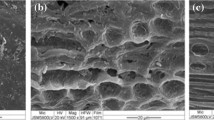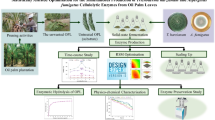Abstract
The aim of this research was to study the production of humic acids (HA) by Trichoderma reesei from empty fruit bunches (EFBs) of palm oil processing, with a focus on the effects of lignocellulosic content and residual lipids. EFBs from two different soils and palm oil producers were previously characterized about their lignocellulosic composition. Submerged fermentations were inoculated with T. reesei spores and set up with or without residual lipids. The results showed that the soil and the processing for removal of the palm fresh fruits were crucial to EFB quality. Thus, EFBs were classified as type 1 (higher lignocellulosic and fatty acids composition similar to the palm oil and palm kernel oil) and type 2 (lower lignocellulosic content and fatty acids composition similar to palm oil). Despite the different profiles, the fungal growth was similar for both EFB types. HA production was associated with fungal growth, and it was higher without lipids for both EFBs. The highest HA productivity was obtained from type 1 EFB (approximately 90 mg L−1 at 48 h). Therefore, the lignocellulosic composition and the nature of the residual lipids in EFBs play an important role in HA production by submerged fermentation.

Similar content being viewed by others
References
Stevenson, F. J. (1994). Humus chemistry: genesis, composition, reactions (2nd ed.). New York: John Wiley & Sons.
Baldotto, M. A., & Baldotto, L. E. B. (2014). Ácidos húmicos. Revista Ceres, 61, 856–881.
Perminova, I. V., Kulikova, N. A. (2008). From molecular understanding to innovative applications of humic substances. Proceedings of the 14th International Meeting of the International Humic Substances Society, vol 2, Moscow – Saint Petersburg Russia.
Melo, B. A. G., Motta, F. L., & Santana, M. H. A. (2016). Humic acids: structural properties and multiple functionalities for novel technological developments. Materials Science and Engineering, 62, 967–974.
Klupfel, K., Piepenbrock, A., Kappler, A., & Sander, M. (2014). Humic substances as fully regenerable electron acceptors in recurrently anoxic environments. Nature Geoscience, 7(3), 195–200.
Hassett, D. J., Bise, M. S. I., & Hartenstein, R. (1987). Bactericidal action of humic acids. Soil Biology Biochemistry, 1, 111–113.
Busato, J. G., Zandonadi, D. B., Dobbss, L. B., Façanha, A. R., & Canellas, L. P. (2010). Humic substances isolated from residues of sugar cane industry as root growth promoter. Scientia Agricola, 67(2), 206–212.
Jasen Van Rensburg, C. E., Badenhorst, E. B., Gandy, J. J., & Snyman, J. R. (2010). Potassium humate reduces inflammation and clinically improves the outcomes of patients with osteoarthritis of the knee. Conference Proceedings Journal., 1, 69–74.
Pacheco, M. L., & Havel, J. (2001). Capillary zone electrophoretic (CZE) study of uranium(VI) complexation with humic acids. Journal of Radioanalytical and Nuclear Chemistry, 248(3), 565–570.
Hu, P., Wang, H., Yang, Y., Yang, J., Lin, J., & Guo, L. (2016). Recent progress on piezoelectric and triboelectric energy harvesters in biomedical systems. Advanced Science., 28, 1–23.
Klocking, R., & Helbig, B. (2005). Medical aspects and applications of humic substances (pp. 3–16). Germany: Wiley VCH.
Miao, Z. H., Li, K., Li, Z., Yang, H., Zhao, Q., Chang, M., Yang, Q., Zhen, L., Xu, C. Y., & Yang, H. (2018). Natural humic-acid-based phototheranostic agent. Advanced Healthcare Materials, 1, 1–9.
Kurnin, N. A. A., Ismail, M. H. S., Yoshida, H., & Izhar, S. (2016). Recovery of palm oil and valuable material from oil palm empty fruit bunch by sub-critical water. Journal of Oleo Science, 4, 283–289.
Isroi, I., Ishola, M. M., Millati, R., Syamsiah, S., Cahyanto , M. N., Niklasson, C., . Taherzadeh, M. J. (2012). Structural changes of oil palm empty fruit bunch (OPEFB) after fungal and phosphoric acid pretreatment. Molecules 17, 14995–15012, 12.
Bocchi, B.(2008), PhD thesis. Estudo de viabilidade de cogeração de uma unidade de extração de óleo de palma integrada a uma usina de biodiesel. Universidade de São Paulo.
Block, J. M., Barrera-Arellano, D. (2013). Introduccion ala química de lípidos, in Temas selectos em aceytes y grasas. vol 3: (Block, J. M., Barrera-Arellano, D.), Blucher,pp. 1–37.
Seiboth, B., Ivanova, C., Seidl-Seiboth, V. (2011).Trichoderma reesei: A fungal enzyme producer for cellulosic biofuels. Biofuel Production-recent Developments And Prospects. 6,309–334.
Motta, F. L., & Santana, M. H. A. (2014). Comparison of humic acids production by Trichoderma viride and Trichoderma reesei using the submerged fermentation of oil palm empty fruit bunch. Journal of Microbiology and Biotechnology, 13, 1067–1074.
Motta, F. L., & Santana, M. H. A. (2013). Production of humic acids from oil palm empty fruit bunch by submerged fermentation with Trichoderma viride: cellulosic substrates and nitrogen sources. Biotechnology Progress, 29(3), 631–637.
Motta, F. L., & Santana, M. H. A. (2012). Biomass production from Trichoderma viride in nonconventional oat medium. Biotechnology Progress, 28(5), 1245–1250.
Motta, M. H., & Santana, A. (2014). Influence of fermentation conditions on humic acids production by Trichoderma viride using an oil palm empty fruit bunch as the substrate. International Journal of Bioengineering and Life Sciences, 8, 375–383.
AOCS. Official Methods and Recommended Practices of the American Oil Chemist’s Society. (2009). 6 ed. Campaing.
AACCI “American Association of Cereal Chemists International” (2010). Approved methods, St. Paul., 11th ed.
Badis, A., Ferradji, F. Z., Boucherit, A., Fodil, D., & Boutoumi, H. (2010). Removal of natural humic acids by decolorizing actinomycetes isolated from different soils (Algeria) for application in water purification. Desalination, 259(1-3), 216–222.
Callow, N., & Ju, L. (2012). Promoting pellet growth of Trichoderma reesei Rut C30 by surfactants for easy separation and enhanced cellulase production. Enzyme and Microbial Technology, 50(6–7), 311–317.
Smith, P. K., Krohn, R. I., Hermanson, G. T., Mallia, A. K., Gartner, F. H., Frovenzano, M. D., Fujimoto, E. K., Goeke, N. M., Olson, B. J., & Klenk, D. C. (1985). Measurement of protein using bicinchoninic acid. Analytical Biochemistry, 150(1), 76–85.
Silva, D. P., Gellen, L. A. F., Chagas Júnior, A. F., & Scheidt, G. N. (2014). Potencial de produção de lipases e fosfolipases por trichoderma harzianum para a indústria de alimentos. Evidência, 14, 69–78.
Vaz, M., & Choupina, A. (2012). Lipases: Biocatalizadores da Hidrólise de Triacilglicerois. Revista Eletrônica de Biologia, 5, 42–58.
Musa, H., Han, P. C., Kasim, F. Z., Gopinath, S. C. B., & Ahmad, M. A. (2017). Turning oil palm empty fruit bunch waste into substrate for optimal lipase secretion on solid state fermentation by Trichoderma strains. Process Biochemistry, 63, 35–41.
Huang, C., Lai, C., Guangming, Z., Huang, D., Xu, P., Zhang, C., Cheng, M., & Wan, J. (2017). Manganese-enhanced degradation of lignocellulosic waste by Phanerochaete chrysosporium: evidence of enzyme activityand gene transcription. Applied Microbiology and Biotechnology, 101, 6541–6549.
Huang, C., Zeng, G., Huang, D., Lai, C., Xu, P., Zhang, C., Cheng, M., Wan, J., Hu, L., & Zhang, Y. (2017). Effect of Phanerochaete chrysosporium inoculation on bacterial community and metal stabilization in lead-contaminated agricultural waste composting. Bioresource Technology, 243, 294–303.
Manisha, & Yadav, S. K. (2017). Technological advances and applications of hydrolytic enzymes for valorization of lignocellulosic biomass. Bioresource Technology, 245, 1727–1739.
Du, J., Zhang, X., Li, X., Zhao, J., Liu, G., Gao, B., & Qu, Y. (2018). The cellulose binding region in Trichoderma reesei cellobiohydrolase I has a higher capacity in improving crystalline cellulose degradation than that of Penicillium oxalicum. Bioresource Technology, 266, 19–25.
Acknowledgments
The authors are grateful for the support given by School of Chemical Engineering (FEQ/UNICAMP), Agropalma, and cooperative of small palm oil producing industries from Muniz Ferreira by supplying of the EFB, and for National Council for Scientific and Technological Development (CNPQ, Brazil).
Author information
Authors and Affiliations
Corresponding author
Ethics declarations
Conflict of Interest
The authors declare that there are no conflict of interests.
Rights and permissions
About this article
Cite this article
Volpi, M., Santos, V., Ribeiro, A. et al. The Role of Lignocellulosic Composition and Residual Lipids in Empty Fruit Bunches on the Production of Humic Acids in Submerged Fermentations. Appl Biochem Biotechnol 187, 957–964 (2019). https://doi.org/10.1007/s12010-018-2850-z
Received:
Accepted:
Published:
Issue Date:
DOI: https://doi.org/10.1007/s12010-018-2850-z




